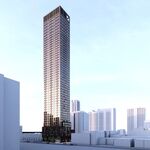But this could peel off ridership from the Yonge Line. We have to think about the entire area, not just the street it's self.
A bit perhaps ... but I'd think it would have most if it's effect if it reaches Eglinton. An LRT might well be more effective north of Eglinton, as by then the subway stop spacing would be so wide, that a lot of people would still have to figure out how to get to the subway. The travel time from Sheppard to Eglinton on the LRT would be still very fast, and would likely result in trips downtown using the Don Mills LRT and DRL that are faster than using the Sheppard subway and Yonge subway.
Currently
Sheppard/Don Mills to King station on the subway is 36 minutes (well, it's a lot worse than that, with the current overcrowding, and the slow order through Davisville, etc. - but let's pretend that they fix it all).
The DRL report estimates 20.5 minutes from Eglinton/Don Mills to King station (using the velocities on Table 2-4, and the distances associates with Exhibit 2-4). Let's assume 2.5 minutes to change from the Don Mills LRT to subway at Don Mills/Eglinton station. To match the travel time of 36 minutes on the subway, you'd have to get from Sheppard/Don Mills to Eglinton/Don Mills in 13 minutes.
The distance from Sheppard/Don Mills to Eglinton/Don Mills is 6.2 km. To travel 6.2 km in 13 minutes, you'd have to do 28.6 km/hour. Which is about what you'd expect from LRT up there.
So pretty much a tie for those right at Don Mills station. But that's a deep station, and it's a good walk for anyone to get to. I bet someone living right on the corner of Don Mills and Sheppard would be onto a surface LRT faster than getting into the subway. And those living at Don Mills/Parkway Forest on near the Peanut would be far better off on the LRT.
Sure, the subway would help some more ... but at what cost.
Still, best not to eliminate these things out-of-hand. There's no reason the demand shouldn't be modelled, to see what would likely happen.




